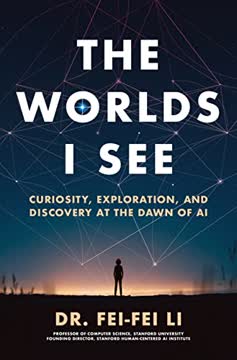Key Takeaways
1. Empathy is the invisible thread weaving human history
The evolution of empathic consciousness is the quintessential underlying story of human history, even if it has not been given the serious attention it deserves by our historians.
Empathy as human essence. Far from being a peripheral trait, empathy lies at the core of human nature and social development. It is the biological mechanism that allows individuals to understand and respond to others' feelings and experiences as if they were their own. This capacity for emotional connection has been a driving force in shaping human societies, institutions, and cultural narratives throughout history.
Historical oversight. Traditional historical accounts have often focused on conflict, power struggles, and technological progress, overlooking the crucial role of empathy in human affairs. However, a closer examination reveals that empathic consciousness has steadily evolved and expanded over time, enabling increasingly complex social structures and fostering cooperation on ever-larger scales.
Paradoxical relationship. The development of empathy is intricately linked to the growth of human civilization and energy consumption. As societies become more complex and interconnected, they create opportunities for broader empathic engagement. However, this progress often comes at the cost of increased environmental exploitation, creating a paradoxical relationship between empathic growth and ecological sustainability.
2. Energy regimes and communication revolutions shape empathic consciousness
The irony is that our growing empathic awareness has been made possible by an ever-greater consumption of the Earth's energy and other resources, resulting in a dramatic deterioration of the health of the planet.
Technological catalysts. Throughout history, major shifts in energy regimes and communication technologies have played a crucial role in expanding human empathy. These advancements create new possibilities for social organization and interaction, allowing people to connect across greater distances and with more diverse groups.
Key energy transitions:
- Neolithic agricultural revolution
- Hydraulic civilizations
- Medieval water and wind power
- Industrial Revolution (coal and steam)
- Second Industrial Revolution (oil and electricity)
Communication revolutions:
- Development of writing
- Invention of the printing press
- Telegraph and telephone
- Radio and television
- Internet and digital technologies
Expanding consciousness. Each new energy-communication complex extends the reach of human awareness and interaction, creating opportunities for empathic engagement on increasingly larger scales. This process has led to the gradual expansion of moral circles and the development of more inclusive social and political structures.
Entropic challenge. The expansion of empathic consciousness has been closely tied to increasing energy consumption and resource exploitation. This creates a fundamental tension between empathic growth and environmental sustainability, posing a significant challenge for the future of human civilization.
3. The rise of selfhood and individuality fuels empathic extension
To be truly human is to be universally empathic and, therefore, morally appropriate in one's embodied experience.
Emergence of the self. The development of a distinct sense of self and individual identity has been crucial in the evolution of empathy. As people became more aware of their own unique experiences and inner lives, they gained the capacity to imagine and relate to the experiences of others more deeply.
Historical progression:
- Tribal consciousness in early human societies
- Emergence of early individualism in hydraulic civilizations
- Growth of urban life and commerce in medieval Europe
- Renaissance humanism and the "discovery of man"
- Enlightenment emphasis on individual rights and reason
- Modern psychological understanding of the self
Paradox of individuality. While the rise of individualism might seem to promote selfishness, it actually creates the cognitive and emotional foundation for more sophisticated forms of empathy. By recognizing oneself as a distinct being, one can better appreciate the unique perspectives and experiences of others.
Empathy as bridge. As individuality becomes more pronounced, empathy serves as a crucial bridge between the self and others. It allows people to maintain social connections and form larger, more complex societies while still preserving a sense of personal identity.
4. Empathy evolves through distinct stages of human development
Empathy is, after all, the feeling of deep reverence we have for the nebulous term we call existence.
Developmental stages. Empathy is not a fixed trait but evolves through distinct stages of human development, both on individual and societal levels. This progression allows for increasingly sophisticated forms of emotional understanding and moral reasoning.
Individual empathy development:
- Primitive empathic distress (infants)
- Egocentric empathy (toddlers)
- Perspective-taking (young children)
- Abstract empathy (adolescents and adults)
- Universal empathy (mature adults)
Societal empathy evolution:
- Tribal empathy (early human societies)
- Religious/cultural empathy (early civilizations)
- National/ethnic empathy (nation-states)
- Global empathy (modern interconnected world)
- Biosphere consciousness (emerging ecological awareness)
Expanding circles. As empathy develops, individuals and societies extend their circle of moral concern to encompass larger groups and more diverse beings. This expansion has been a driving force behind moral progress, social reform, and the development of universal human rights.
Challenges and limitations. While empathy has the potential for continuous growth, it also faces limitations and challenges. These include cognitive biases, in-group preferences, and the difficulty of extending empathy to abstract or distant entities like future generations or the biosphere as a whole.
5. Theological consciousness marks the first great empathic surge
The coming of Christianity certainly did not signal the end of the "dark ages" for children, yet it may well have meant the beginning of a slightly less grim outlook.
Religious transformation. The emergence of monotheistic religions, particularly Christianity, marked a significant leap in empathic consciousness. These belief systems introduced the concept of universal love and compassion, extending moral concern beyond tribal or ethnic boundaries.
Key empathic innovations:
- Concept of a universal God concerned with all humanity
- Emphasis on individual worth and dignity
- Idea of loving one's enemies
- Expansion of moral circles beyond kin and tribe
- Development of universal ethical principles (e.g., Golden Rule)
Institutional paradox. While religious institutions often became sources of conflict and oppression, the underlying spiritual messages continued to promote empathic ideals. This tension between institutional power and empathic teachings has been a recurring theme in religious history.
Legacy and limitations. The empathic surge initiated by theological consciousness laid important groundwork for later moral and social developments. However, it was limited by hierarchical social structures, exclusionary practices, and the inability to fully reconcile empathic ideals with existing power dynamics.
6. Print revolution and humanism expand empathic boundaries
Print communications strengthened the sense of individuality at the expense of loosening older communal ties. But, it also had the effect of connecting individuals in new kinds of affiliations and connections that stretched across broader swaths of space and time.
Transformative technology. The invention of the printing press in the 15th century revolutionized communication and knowledge dissemination, profoundly impacting human consciousness and social organization.
Empathic impacts of print:
- Spread of literacy and education
- Standardization of languages
- Dissemination of new ideas and perspectives
- Creation of "imagined communities" through shared texts
- Development of introspective reading and writing practices
Humanist awakening. The print revolution coincided with and fueled the humanist movement, which emphasized individual dignity, rational inquiry, and the value of diverse human experiences. This cultural shift expanded empathic boundaries by promoting curiosity about other cultures and perspectives.
Paradoxical effects. While print technology strengthened individuality and weakened some traditional communal bonds, it also created new forms of connection and shared identity. These new affiliations, based on shared ideas and interests rather than proximity or kinship, laid the groundwork for more expansive forms of empathy and social organization.
7. Modern family dynamics foster empathic growth
The advent of companionate marriage and marriages based on love didn't take hold easily or quickly but, rather, emerged in stages.
Shift in family structure. The transition from extended kinship networks to nuclear families based on companionate marriage marked a significant change in social organization and empathic development.
Key transformations:
- Rise of affectionate marriages
- Increased focus on child-rearing and education
- Development of the concept of childhood as a distinct life stage
- Growing emphasis on emotional bonds within the family
- Shift from patriarchal authority to more egalitarian relationships
Empathic nursery. The modern family structure, with its emphasis on emotional intimacy and individual development, became a crucial environment for fostering empathic skills. Children raised in nurturing, affectionate households were better equipped to develop sophisticated empathic abilities.
Societal ripple effects. The changes in family dynamics had broader societal impacts, influencing ideas about individual rights, gender roles, and social responsibility. These shifts created a more fertile ground for expanding empathic consciousness beyond the family unit to larger social spheres.
8. Empathy and entropy exist in paradoxical tension
We are in a race to biosphere consciousness in a world facing the threat of extinction.
Fundamental dilemma. The development of empathic consciousness is inextricably linked to the growth of human civilization and energy consumption. This creates a paradoxical situation where empathic expansion often comes at the cost of increased environmental exploitation.
Key aspects of the paradox:
- Empathy requires complex social structures
- Complex societies demand higher energy consumption
- Increased energy use leads to environmental degradation
- Environmental crisis threatens human survival and empathic progress
Race against time. As human empathy expands to encompass the entire biosphere, we face the urgent challenge of reconciling our empathic growth with the need for ecological sustainability. This race between empathic consciousness and entropic collapse defines the current moment in human history.
Potential resolutions:
- Development of sustainable energy technologies
- Reimagining social and economic systems
- Cultivating a global empathic consciousness
- Balancing individual needs with collective well-being
- Fostering a deep connection to the natural world
The resolution of this paradox may determine the future course of human civilization and our ability to continue expanding empathic consciousness while preserving the ecological foundations that support life on Earth.
Last updated:
FAQ
What's The Empathic Civilization about?
- Exploration of Empathy: Jeremy Rifkin explores the evolution of human empathy and its critical role in shaping civilization. He argues that empathy is a fundamental aspect of human nature.
- Historical Context: The book traces the development of empathy through various historical stages, highlighting its influence on social, economic, and political structures.
- Empathy vs. Entropy: Rifkin discusses the paradoxical relationship between empathy and resource consumption, suggesting that increased interconnectedness leads to environmental crises.
- Future Implications: The author envisions a future where empathy guides global consciousness, essential for addressing crises like climate change and social inequality.
Why should I read The Empathic Civilization?
- Understanding Human Evolution: The book provides insights into how empathy has influenced human development, relevant for those interested in psychology, sociology, or history.
- Addressing Global Crises: Rifkin connects empathy with the urgent need to tackle climate change and resource depletion, making it a timely read for concerned individuals.
- New Perspective on Relationships: It challenges traditional views of human nature, encouraging readers to rethink their understanding of relationships, morality, and social responsibility.
- Vision for the Future: The book offers a hopeful vision for a more empathic and sustainable future, inspiring action towards a compassionate world.
What are the key takeaways of The Empathic Civilization?
- Empathy as Core Trait: Empathy is a fundamental aspect of human nature, essential for social cohesion and moral development.
- Impact of Environment: Nurturing environments foster empathic development in children, crucial for emotional and social growth.
- Crisis of Empathy and Entropy: While global empathy is within reach, environmental degradation and resource depletion pose significant challenges.
- Shift to Collaboration: Rifkin advocates for a shift from competition to collaboration, essential for addressing global challenges.
What are the best quotes from The Empathic Civilization and what do they mean?
- “Growing empathic awareness...”: This quote highlights the paradox of modern civilization, where increased empathy comes at the cost of environmental sustainability.
- “Can we reach global empathy...”: It emphasizes the urgency of fostering global empathy to address pressing global challenges, calling for collective action.
- “Empathy is the very means...”: This statement underscores the book's thesis that empathy drives societal progress, not just a personal trait.
- “The win/lose game gives way...”: It encapsulates the shift from competitive to collaborative frameworks, suggesting progress through mutual benefit.
How does The Empathic Civilization redefine human nature?
- Shift from Aggression: The book challenges the belief that humans are inherently aggressive, proposing empathy as our fundamental nature.
- Role of Mirror Neurons: Rifkin discusses mirror neurons as the biological basis for empathy, allowing individuals to resonate with others' feelings.
- Cultural Influences: While empathy is biologically rooted, its expression is shaped by cultural and environmental factors, especially during childhood.
- Empathy as Survival Mechanism: Empathy is crucial for civilization's survival, fostering cooperation and understanding to address complex challenges.
What is the empathy/entropy paradox discussed in The Empathic Civilization?
- Interconnectedness and Resource Use: The paradox refers to the relationship between increasing global empathy and escalating resource consumption, leading to environmental degradation.
- Historical Context: As societies evolve, they require more energy, heightening empathic sensitivity but accelerating resource depletion.
- Future Implications: Resolving this paradox is crucial for humanity's survival, necessitating a rethinking of economic and social models for sustainability.
- Empathy vs. Entropy: The book suggests that while empathy grows, it must be balanced with sustainable practices to prevent environmental crises.
How does The Empathic Civilization connect empathy to economic systems?
- Distributed Capitalism: Rifkin discusses how empathy leads to new economic models prioritizing collaboration and shared resources over competition.
- Impact on Business: Businesses recognize empathy's value in fostering better workplace relationships and improving performance.
- Sustainability and Empathy: An empathic approach to economics can address environmental challenges by promoting sustainable practices and social responsibility.
- Access Rights: The book suggests a shift from property rights to access rights, reflecting changing societal values towards shared resources.
What role does childhood development play in fostering empathy in The Empathic Civilization?
- Critical Early Experiences: Early interactions with caregivers shape a child's ability to empathize, with nurturing environments leading to healthier emotional development.
- Induction Discipline: Rifkin introduces induction discipline, guiding children to understand their actions' impact on others, fostering empathy and moral responsibility.
- Long-term Effects: Childhood empathy development links to better social relationships and emotional well-being in adulthood, highlighting supportive parenting's importance.
- Empathy Curriculum: The book advocates for educational reforms incorporating empathy training, laying the foundation for a compassionate society.
How does The Empathic Civilization address the relationship between empathy and morality?
- Empathy as Moral Foundation: Empathy is the basis for moral behavior, allowing individuals to understand and respond to others' feelings.
- Guilt and Responsibility: Empathic distress can lead to guilt, motivating individuals to make amends and act morally.
- Cultural Variations: Different cultures emphasize various empathy and morality aspects, influencing how individuals express moral responsibilities.
- Empathy in Action: Rifkin argues that empathy must translate into action, urging compassionate behavior towards others.
What is the significance of biosphere consciousness in The Empathic Civilization?
- Interconnectedness of Life: Biosphere consciousness emphasizes the interconnectedness of all living beings and the environment, crucial for fostering empathy.
- Sustainable Practices: It encourages adopting sustainable practices that respect the biosphere, leading to responsible consumption and resource management.
- Global Collaboration: Biosphere consciousness calls for global collaboration to address environmental challenges, fostering shared responsibility for the planet.
- Empathy and Environment: Recognizing this relationship is essential for developing sustainable practices that respect human and environmental needs.
How does The Empathic Civilization envision the future of humanity?
- Towards Homo Empathicus: Rifkin envisions humanity evolving into Homo empathicus, characterized by deep empathic connections, essential for addressing global challenges.
- Sustainable Practices: The book advocates adopting sustainable practices reflecting empathic values, prioritizing the planet's and its inhabitants' well-being.
- Global Consciousness: A global consciousness transcending national and cultural boundaries fosters cooperation and solidarity among diverse peoples.
- Empathy as Guiding Principle: Rifkin encourages fostering empathy in communities and beyond, essential for creating a just and equitable society.
Review Summary
The Empathic Civilization receives mostly positive reviews for its ambitious scope and thought-provoking ideas. Readers appreciate Rifkin's historical analysis of human consciousness and empathy, though some find the book overlong. Many reviewers praise the book's insights on human nature, technology, and global challenges. Critics note occasional repetitiveness and question some of Rifkin's conclusions. Overall, readers find the book informative and perspective-changing, despite its length and complexity. The book's exploration of empathy as a driving force in human development resonates with many.
Similar Books










Download PDF
Download EPUB
.epub digital book format is ideal for reading ebooks on phones, tablets, and e-readers.






